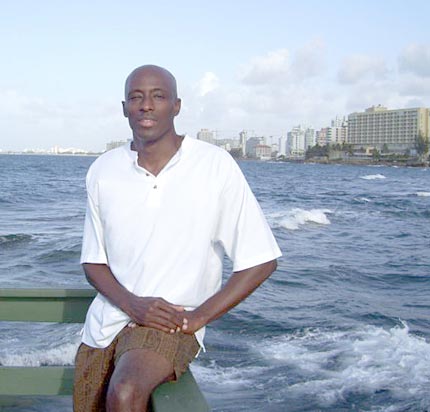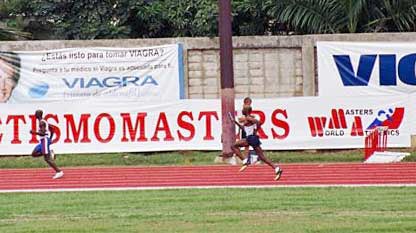Book review: ‘That Masterful Season’ by Cornell Stephenson
Posted April 28, 2008

Cornell Stephenson made a return trip to Puerto Rico in 2007 after winning four medals (including two relay golds) at the 2003 world masters championships there.
Four years ago, Cornell Stephenson of Los Angeles helped set an M40 world record in the 4√ó100, joining Speedwest teammates Frank Strong, Kettrell Berry and Willie Gault in a 42.20 clocking at the Steve Scott Invitational in Irvine, California.
At the 2003 Penn Relays, he had been runner-up in the M40 100 with an 11.40. That summer culminated with gold medals at the Puerto Rico world masters championships in the 4√ó100 and 4√ó400. Cornell also took silver in the 100 and bronze in the 200 at worlds.
In addition, Cornell claims an M40 masters best of 48.94 in the 400 and a world record in the distance medley relay.
Not bad. Plenty to write home about.
But unlike any other masters track athlete in history, Cornell has done more than just recount his favorite meets and feats. He wrote a novel ‚Äď 212 pages including an index and seven pages of black-and-white photos.
‚ÄúThat Masterful Season,‚ÄĚ self-published this year under the Xlibris imprint, is the first literary work of fiction to make masters track and field its centerpiece.
Author Cornell Mark Stephenson, a middle school coach and teacher, says many people had enjoyed his memoirs of worlds, Penn and the various vacations associated with masters meets and encouraged him to write a book. ‚ÄúOnce the feeling came from within,‚ÄĚ he told me recently, ‚ÄúI gave it my best shot.‚ÄĚ
The plot is simple: Eight M40 or M45 elite sprint buddies ‚Äď four on the West Coast and four on the East ‚Äď prepare for Penn, compete at the 2003 Relays, juggle work and personal lives and finish up (most of them) at the 15th World Masters Athletics Championships in Carolina, Puerto Rico, in July 2003.¬† It‚Äôs a quick read ‚Äď I finished its 45 bite-sized chapters in two sittings.
Early on, I applauded Cornell on how he nailed the complicated lives of masters athletes ‚Äď who fight daily battles to balance jobs, family duties and training sessions. Many sports novels focus on the young and care-free, certainly not athletes fretting about expanding their sales lines or navigating office politics.
I didn‚Äôt expect Hemingway or Steinbeck, but Cornell managed to hold my attention and draw me into his characters and their challenges. It‚Äôs written in the third person, however, and its constantly shifting scenes ‚Äď like a time-shifting Hollywood movie with an ensemble cast ‚Äď gets confusing at times. (Who is Greg again? What was Bernard up to last?)
But aside from the imaginary drama of midcareer men balancing the demands of track, family and work is this intriguing subtext:
Everyone in the book was inspired by a living, breathing person.
So here’s why I really paid attention:

Cornell is shown leading off the gold-medal American 4x400 relay at 2003 worlds with a 48.9-second leg.
How much of M45 character Dr. Beree Riggins ‚ÄĒ an East Coast heart surgeon in the book ‚ÄĒ is drawn from true-life cardiothoracic surgeon Ray Blackwell of Delaware?
How much of M40 character Alan Simpson ‚ÄĒ whose cherished wife, Linda, is undergoing chemotherapy ‚ÄĒ is true-life star Sal Allah, whose beloved wife, Lynn, died of breast cancer in 2005?
How much of M40 character Greg Jackson of Los Angeles ‚Äď with an ex-wife and a teen-age daughter ‚Äď was San Diego‚Äôs Kettrell Berry, who has an ex-wife and track-star teen daughter?
Even M55 superstar Bill Collins of Houston, M40 hurdle champion Darnell Gatling and USA Team Manager Sandy Pashkin have cameos in ‚ÄúThat Masterful Season.‚Ä̬† In the novel, the team manager at Puerto Rico is Sheila Proctor, and a 400 hurdler on the American 4√ó4 team is Donnie Garrison.
And take one guess who this is:
‚ÄúIt was finally time to start the 400 finals for the 50-54 division. The race was highly anticipated due to the presence of Houston native Colin Williams who at one time or another owned a dozen different masters records from the 100 to the 400 as well as both sprint relays.‚ÄĚ
Even foreign athletes get their moment in Cornell‚Äôs sun. The novel mentions ‚Äúcurrent world record holder (at 400) Pietro Franconi‚ÄĚ of Italy. Of course, this is a tip of the hat to real-life M40 WR man: Enrico Saraceni of Italy (who didn‚Äôt run at Puerto Rico, by the way.)
And I doubt the book’s Tri-state Allstars are anything but Sprint Force America.
Cornell doesn‚Äôt deny the obvious, telling me: ‚ÄúAll of the main characters are based on combinations of masters competitors whom I‚Äôve admired, but with fictional lives.‚ÄĚ
Therein lies the rub. How do you build a gripping novel ‚Äď which normally includes bad guys, good guys and dicey situations ‚Äď when the key characters are based on real people (and respected friends)?¬† You can‚Äôt.
Although I appreciate the way Cornell depicts the lives of elite masters sprinters, the book’s tone is unrelentingly optimistic. Setbacks are minor, conflicts few. Just about everyone runs a 50-flat quarter, wins a medal or sets a record, and the main characters are all solid citizens. How dull.
Although I appreciated Cornell‚Äôs careful sketching of masters circuit details (slipped blocks, dropped batons, hamstring tweaks, etc.), we never really get into anyone‚Äôs head. The book reads like a screenplay, with exhaustive details (sweatsuit colors, auto makes, shoe brands) carefully sprinkled throughout. But instead of learning what the characters feel, we only hear what they say. Dialog is essential to a good screenplay, but inner conversations are lacking in ‚ÄúThat Masterful Season.‚ÄĚ
I asked Cornell if he‚Äôd ever written for movies, and he replied: ‚ÄúI‚Äôve never written a screenplay, but this idea actually started out as one. However, that takes a lot of experience and a book can always be adapted into a screenplay.‚ÄĚ
Further, he told me: ‚ÄúThe initial inspiration stemmed from witnessing Sprint Force America set the 4√ó400 record in 2001 and feeling that we had enough talent on the West Coast to defeat them once we turned 40 for the 2003 season.‚ÄĚ
Besides offering some bad guys, ‚ÄúThat Masterful Season‚ÄĚ could have picked a prime protagonist. Cornell almost does that with Marc Minor, a single guy with feisty-girlfriend problems. Marc appears in the opening and closing chapters. Marc shares elements of Cornell‚Äôs own life story.
Cornell, who describes himself as ‚Äúa single father with a 7-year-old son who will be faster than I was,‚ÄĚ registered for my masterstrack.com Forum on March 19 with a familiar handle. On this message board, he goes by marcminor.
Sex is suggested at various points in the book, but no raunchy details. And guess which character has the most fun?
On page 121: ‚ÄúMarc was ecstatic and pulled Diane into bed with him and slowly caressed her loveliness. He told her how inspired he‚Äôd be with her in the stands supporting him. Diane was very thrilled to see Marc‚Äôs reaction and showed it with a long hot kiss. Together they displayed their affection for one another late into the warm summer night.‚ÄĚ
Aw, Cornell. Don’t stop now!
A blurb written to promote the book says, ‚Äú¬†‚ÄėThat Masterful Season‚Äô ‚ÄĚ reads as fast as its characters run but doesn‚Äôt feel rushed. It will move and inspire you to do what truly brings joy.‚ÄĚ
That’s nice, but novels generally don’t set out to inspire true-joy-seeking. They’re supposed to whisk you into an invented world and excite your imagination.
‚ÄúThat Masterful Season,‚ÄĚ while creative in its situations and honest in its depictions, ends up tripping, uninspired, at the finish line.




